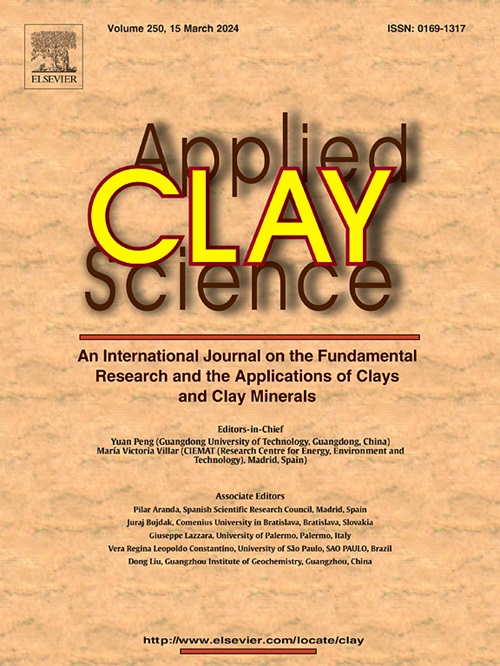Facile modification of sepiolite and its application in wear-resistant and superhydrophobic epoxy coatings by mimicking the structure of shark skin
IF 5.3
2区 地球科学
Q2 CHEMISTRY, PHYSICAL
引用次数: 0
Abstract
Superhydrophobic surfaces have demonstrated significant potential in various fields. Nonetheless, creating durable superhydrophobic surfaces with practical application value remains a major challenge. This study utilizes biomimicry to prepare a series of composites similar to shark skin, which possesses hydrophobic and wear-resistant properties. A dual-coating strategy was developed to create a durable and wear-resistant superhydrophobic surface. This article introduces a novel approach by incorporating chemically modified sepiolite and graphite nanoparticles in a layer-by-layer composite for enhancing wear resistance in epoxy resin coatings. Epoxy resin (EP) was used as the matrix material, graphite nanoparticles (GNP) were incorporated for the wear-resistant layer, and modified superhydrophobic Sepiolite (osSep) particles were utilized for the superhydrophobic layer. Both of these layers could form hydrogen bonds with epoxy resin, leading to a functional coating that offers wear resistance, superhydrophobicity, chemical stability, and self-cleaning properties. This article applies EP@GNP@osSep composites to glass, wood, and stainless steel mesh, imparting excellent superhydrophobic properties, wear resistance, self-cleaning abilities, and anti-staining properties. The superhydrophobic coating prepared in this manuscript can meet the requirements of robustness and superhydrophobicity for various materials, with promising market potential.
模仿鲨鱼皮结构的海泡石易改性及其在耐磨超疏水环氧涂料中的应用
超疏水表面在许多领域显示出巨大的潜力。然而,创造具有实际应用价值的耐用超疏水表面仍然是主要挑战。本研究利用仿生学技术制备了一系列类似鲨鱼皮的复合材料,具有疏水和耐磨性能。开发了一种双涂层策略,以创建持久耐磨的超疏水表面。本文介绍了一种新的方法,将化学改性海泡石和石墨纳米颗粒加入到一层一层的复合材料中,以提高环氧树脂涂层的耐磨性。采用环氧树脂(EP)为基体材料,石墨纳米颗粒(GNP)为耐磨层,改性超疏水海泡石(osSep)为超疏水层。这两层都可以与环氧树脂形成氢键,从而形成具有耐磨性、超疏水性、化学稳定性和自清洁性能的功能性涂层。本文将EP@GNP@osSep复合材料应用于玻璃,木材和不锈钢网,赋予优异的超疏水性,耐磨性,自清洁能力和抗染色性能。本文制备的超疏水涂层能够满足各种材料对鲁棒性和超疏水性的要求,具有广阔的市场潜力。
本文章由计算机程序翻译,如有差异,请以英文原文为准。
求助全文
约1分钟内获得全文
求助全文
来源期刊

Applied Clay Science
地学-矿物学
CiteScore
10.30
自引率
10.70%
发文量
289
审稿时长
39 days
期刊介绍:
Applied Clay Science aims to be an international journal attracting high quality scientific papers on clays and clay minerals, including research papers, reviews, and technical notes. The journal covers typical subjects of Fundamental and Applied Clay Science such as:
• Synthesis and purification
• Structural, crystallographic and mineralogical properties of clays and clay minerals
• Thermal properties of clays and clay minerals
• Physico-chemical properties including i) surface and interface properties; ii) thermodynamic properties; iii) mechanical properties
• Interaction with water, with polar and apolar molecules
• Colloidal properties and rheology
• Adsorption, Intercalation, Ionic exchange
• Genesis and deposits of clay minerals
• Geology and geochemistry of clays
• Modification of clays and clay minerals properties by thermal and physical treatments
• Modification by chemical treatments with organic and inorganic molecules(organoclays, pillared clays)
• Modification by biological microorganisms. etc...
 求助内容:
求助内容: 应助结果提醒方式:
应助结果提醒方式:


